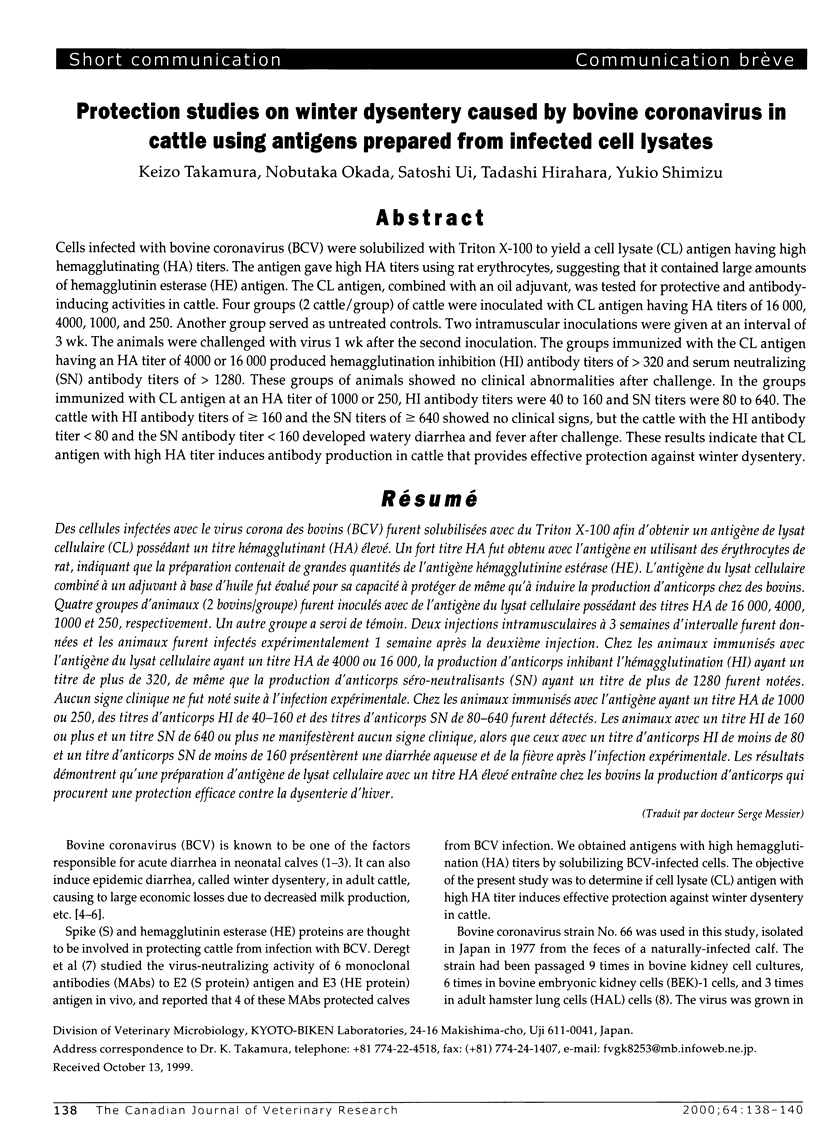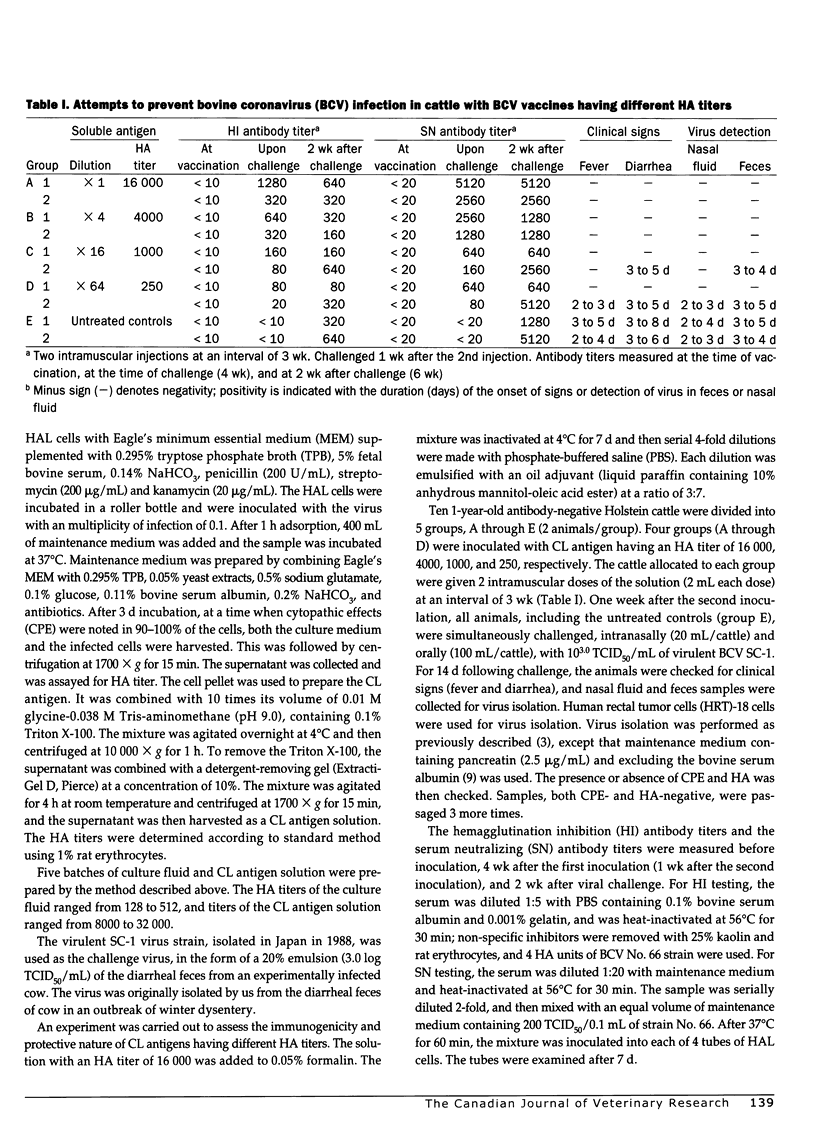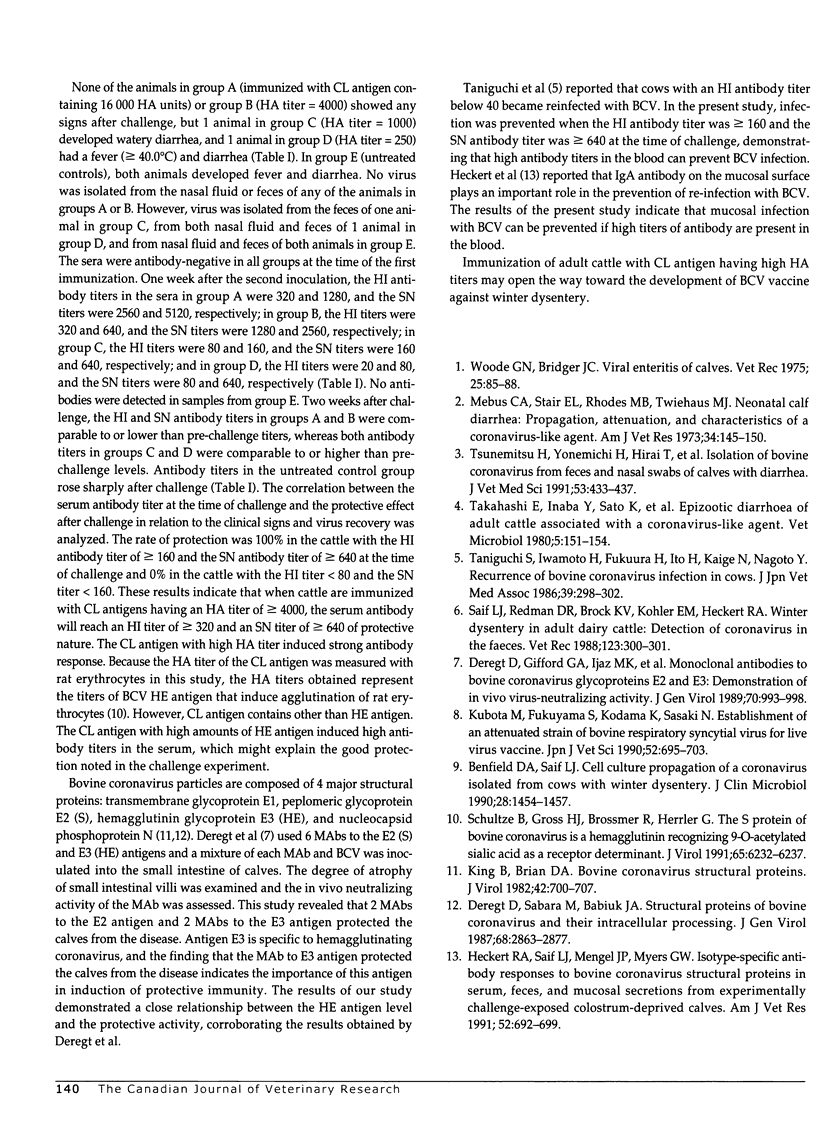Abstract
Cells infected with bovine coronavirus (BCV) were solubilized with Triton X-100 to yield a cell lysate (CL) antigen having high hemagglutinating (HA) titers. The antigen gave high HA titers using rat erythrocytes, suggesting that it contained large amounts of hemagglutinin esterase (HE) antigen. The CL antigen, combined with an oil adjuvant, was tested for protective and antibody-inducing activities in cattle. Four groups (2 cattle/group) of cattle were inoculated with CL antigen having HA titers of 16 000, 4000, 1000, and 250. Another group served as untreated controls. Two intramuscular inoculations were given at an interval of 3 wk. The animals were challenged with virus 1 wk after the second inoculation. The groups immunized with the CL antigen having an HA titer of 4000 or 16 000 produced hemagglutination inhibition (HI) antibody titers of > 320 and serum neutralizing (SN) antibody titers of > 1280. These groups of animals showed no clinical abnormalities after challenge. In the groups immunized with CL antigen at an HA titer of 1000 or 250, HI antibody titers were 40 to 160 and SN titers were 80 to 640. The cattle with HI antibody titers of > or = 160 and the SN titers of > or = 640 showed no clinical signs, but the cattle with the HI antibody titer < 80 and the SN antibody titer < 160 developed watery diarrhea and fever after challenge. These results indicate that CL antigen with high HA titer induces antibody production in cattle that provides effective protection against winter dysentery.
Full text
PDF


Selected References
These references are in PubMed. This may not be the complete list of references from this article.
- Benfield D. A., Saif L. J. Cell culture propagation of a coronavirus isolated from cows with winter dysentery. J Clin Microbiol. 1990 Jun;28(6):1454–1457. doi: 10.1128/jcm.28.6.1454-1457.1990. [DOI] [PMC free article] [PubMed] [Google Scholar]
- Deregt D., Gifford G. A., Ijaz M. K., Watts T. C., Gilchrist J. E., Haines D. M., Babiuk L. A. Monoclonal antibodies to bovine coronavirus glycoproteins E2 and E3: demonstration of in vivo virus-neutralizing activity. J Gen Virol. 1989 Apr;70(Pt 4):993–998. doi: 10.1099/0022-1317-70-4-993. [DOI] [PubMed] [Google Scholar]
- Deregt D., Sabara M., Babiuk L. A. Structural proteins of bovine coronavirus and their intracellular processing. J Gen Virol. 1987 Nov;68(Pt 11):2863–2877. doi: 10.1099/0022-1317-68-11-2863. [DOI] [PubMed] [Google Scholar]
- Heckert R. A., Saif L. J., Mengel J. P., Myers G. W. Isotype-specific antibody responses to bovine coronavirus structural proteins in serum, feces, and mucosal secretions from experimentally challenge-exposed colostrum-deprived calves. Am J Vet Res. 1991 May;52(5):692–699. [PubMed] [Google Scholar]
- King B., Brian D. A. Bovine coronavirus structural proteins. J Virol. 1982 May;42(2):700–707. doi: 10.1128/jvi.42.2.700-707.1982. [DOI] [PMC free article] [PubMed] [Google Scholar]
- Kubota M., Fukuyama S., Kodama K., Sasaki N. Establishment of an attenuated strain of bovine respiratory syncytial virus for live virus vaccine. Nihon Juigaku Zasshi. 1990 Aug;52(4):695–703. doi: 10.1292/jvms1939.52.695. [DOI] [PubMed] [Google Scholar]
- Mebus C. A., Stair E. L., Rhodes M. B., Twiehaus M. J. Neonatal calf diarrhea: propagation, attenuation, and characteristics of a coronavirus-like agent. Am J Vet Res. 1973 Feb;34(2):145–150. [PubMed] [Google Scholar]
- Saif L. J., Redman D. R., Brock K. V., Kohler E. M., Heckert R. A. Winter dysentery in adult dairy cattle: detection of coronavirus in the faeces. Vet Rec. 1988 Sep 10;123(11):300–301. doi: 10.1136/vr.123.11.300. [DOI] [PubMed] [Google Scholar]
- Schultze B., Gross H. J., Brossmer R., Herrler G. The S protein of bovine coronavirus is a hemagglutinin recognizing 9-O-acetylated sialic acid as a receptor determinant. J Virol. 1991 Nov;65(11):6232–6237. doi: 10.1128/jvi.65.11.6232-6237.1991. [DOI] [PMC free article] [PubMed] [Google Scholar]
- Tsunemitsu H., Yonemichi H., Hirai T., Kudo T., Onoe S., Mori K., Shimizu M. Isolation of bovine coronavirus from feces and nasal swabs of calves with diarrhea. J Vet Med Sci. 1991 Jun;53(3):433–437. doi: 10.1292/jvms.53.433. [DOI] [PubMed] [Google Scholar]
- Woode G. N., Bridger J. C. Viral enteritis of calves. Vet Rec. 1975 Jan 25;96(4):85–88. doi: 10.1136/vr.96.4.85. [DOI] [PubMed] [Google Scholar]


